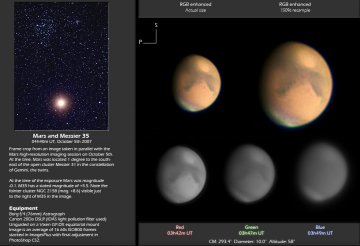 Where's Saturn? Is that a UFO--or the ISS? What's the name of that star? Get the answers from mySKY--a fun new astronomy helper from Meade. . Where's Saturn? Is that a UFO--or the ISS? What's the name of that star? Get the answers from mySKY--a fun new astronomy helper from Meade. . DAWN SKY SHOW: Set your alarm, there's going to be a beautiful display in the pre-dawn sky on Sunday morning. The slender crescent Moon is gliding by Venus to meet up with Saturn and all three will be gathered together in a patch of sky small enough to cover with your outstretched palm. Instructions: Wake up at 5 am and look east, you can't miss it: sky map. EXTRA--DAYLIGHT VENUS: Yesterday in England, Andy Stephens noticed Venus in broad daylight "as clearly visible as a silver spark" in the blue sky. Indeed, the planet is bright enough to see naked-eye during the day; the trick is finding it. This weekend, the Moon shows the way: "the presence of the crescent Moon near Venus will make picking up Venus much easier than normal," notes Stephens. If you see the Moon, scan the sky around it for a silver spark--no telescope required. SUNSPOT GENESIS: A new sunspot is rapidly emerging near the center of the solar disk. Yesterday it was invisible, today it is wider than Earth. Showing just how fast the spot is growing, this SOHO movie spans less than five hours: 
"Today we saw the new sunspot and experienced pareidolia, the sense of seeing faces or object in the sky," reports John Stetson of South Portland, Maine. "This sunspot looked like a flyfishing fly." 
The wings of the fly are dark magnetic filaments connecting the north and south poles of the sunspot. Stetson took the picture with the aid of his students A. Groff, P. Presby and C. Keller and a Coronado SolarMax90. Solar photographers, keep an eye on the sun this weekend. If the rapid growth continues, this lure could become very large indeed. more images: from Cai-Uso Wohler of Bispingen, Germany; from Pavol Rapavy of Rimavska Sobota, Slovakia; from Yvan Trembley of Villepreux in France; from John M Candy of Whitley Bay, North Tyneside, UK RED PLANET: In case you haven't heard, Earth is hurtling toward Mars for a close encounter in December. But why wait? The Red Planet is already a fine target for backyard telescopes in October. This morning in Selsey, UK, amateur astronomer Pete Lawrence took these pictures: 
"During my photo session, I noticed that Mars was pretty close to the star cluster M35," notes Lawrence. "A quick check on a chart and I realized I could capture both objects in the same field of view, shown in the inset at left." The surface features seen in Lawrence's high-resolution images aren't painted on or created by computer model--they're real. "Mars is finally starting to show some decent detail for modest backyard telescopes," agrees Joel Warren who recorded this view through his 8-inch backyard 'scope in Amarillo, Texas. Ready to see for yourself? Mars is shining red and bright in the eastern sky before sunrise. You can't miss it: sky map.
September 2007 Aurora Gallery
[August 2007 Aurora Gallery] [Aurora Alerts] | 
